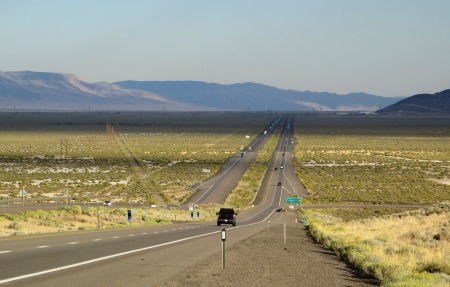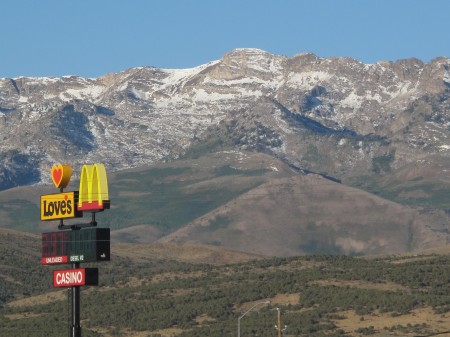‘It is death to every one of you… to travel a distance so great as that through a trackless desert.’ – William Sublette, 1842
‘This is, I think, one of the most detestable countries God ever made, to say nothing of its sterility and barrenness.’ – James Wilkins in the Nevada desert, August 20th 1849
‘Here indeed was a picture of misery… dead horses and oxen, in great numbers… and men, without a morsel to eat, were… offering all they had for a little dry bread.’ – John Clapp in the Forty-Mile Desert in Nevada, July 15th 1850
‘The desert! You must see it and feel it on in a August day… to realise it in all its horrors. But heaven save you from the experience.’ – Eleazar Ingalls, August 5th 1850
It was the third dead cow that really gave us pause. We followed a faint track through the sagebrush beside the Southern Pacific railway line for most of a hot, dusty day, kicking balls of dry tumbleweed out of our way. The first cow carcass we passed was still bloated and fly-blown; the next one a sunken, shrivelled skin; the last a bare, bleached skeleton. Everything that grew along the track was viciously thorny and seemed to want to scratch or prick us, especially the tiny, mace-like burrs that attached themselves to our socks and calves and detached sharp spikes into our fingers, like cluster bombs deploying. It was fiercely hot, as it had been all week, and we had no signal on our phone. This would be a poor place, we reflected, to break an ankle.
We had stiffened our resolve and set out into the desert after a day off in Winnemucca, a small town that was equal parts interstate stop, mining boomtown, casino strip and brothel district, and not without a certain rough charm. Many of the Chinese labourers who worked on the Central Pacific Railroad subsequently settled here. They were visited in 1911by Sun Yat-Sen, just before he became president of the new Chinese republic, surely the only Chinese premier ever to visit Nevada (with the exception, of course, of Chairman Mao’s infamous ‘lost weekend’ with Frank Sinatra and Dean Martin at the Sands in Las Vegas in 1964).
For three days we followed ranch-tracks across the scrub, setting off at dawn in near-freezing temperatures, and enjoying a single hour of equable temperatures between nine o’clock, when we took off our woollen hats, and ten, when we put on our sun-hats. The tracks often degenerated into dust, several inches thick, as fine and yielding as flour, which we sank down into up to our ankles. It seemed impossible that they didn’t simply blow away.
For three days we didn’t see a car, or, for that matter, a human being, though we weren’t alone: just after dawn one morning, a herd of nine antelope clattered slowly across the road just thirty yards ahead of us, close enough for us to see the steam rising off their backs. Later on, we walked through a herd of Holstein cows, which considered us gravely for a full minute before deciding that their best course of action was a full-blown, panicked stampede. And just outside Mill City, we came over a gentle rise to find a pale, silvery snake, perhaps two feet long, curled up in the middle of the road. It reared and struck at my poles, and after a Mexican stand-off lasting a full minute, flowed away into the undergrowth and vanished.
For most of our route through Nevada we had been following the course of the Humboldt River, which rises in lush pastures near Wells and winds for 300 miles across the north of the state. The first European to see it was Peter Ogden in 1828, who named it ‘Unknown River’. Unsurprisingly, this name didn’t stick, and the Humboldt was known as ‘Paul’s River’, ‘Mary’s River’, ‘Swampy River’ and even ‘Ogden’s River’ before in 1848 the great explorer John Fremont named it, rather quixotically, after a German naturalist who had never even set foot in the American West. Barely known even in America, the Humboldt provided a viable route for some of the hardest stages of the California Trail, the transcontinental railroad and, more recently, I-80.
Truth to tell, though, it was decidedly unimpressive to look at, meandering in a shallow channel across the gravelly plain, and occasionally crossing beneath the road in a sluggish trickle that we could easily have waded across without getting our knees wet. Just beyond Lovelock, it finally gave up the unequal struggle against the desert and expired in a featureless, salty pan called the Humboldt Sink.
Lovelock lay at the edge of the Big Meadows, a near-miraculous oasis of canals, horse-ranches and hay-fields, where the early emigrants would stop to rest and water themselves and their animals before tackling the horrors of the Forty-Mile Desert. Despite its efforts to promote the ‘Lover’s Lock Plaza’, where couples are encouraged to buy and affix padlocks proclaiming their love, the town is more infamous today as the involuntary residence of O. J. Simpson, serving a 33-year sentence at the local prison.
A historical marker beside exit 83 of the interstate described the Forty-Mile Desert as ‘a barren stretch of waterless alkali wasteland… the single most dreaded section of the entire California Trail.’ Not much has changed in the last 150 years. Our usual strategy for interstate walking on hot days is to rest underneath exit bridges, but here there was only a single one along a thirty-mile stretch of otherwise utterly shadeless road. The driver of a breakdown truck attending to a pick-up on the shoulder looked at us dubiously as we walked past him.
“You guys got enough water? It’s a long way into town. Gonna be about 96 today.”
We passed the 3,000-mile mark on our walk in the middle of a salty plain, reeking both of the sulphur hissing from geothermal vents in the ground and the outflow from the vents of the Olam onion processing plant. We sweated out liquid as fast as we could drink it, and, under a pale white sky pouring out heat, apparently in sympathy with the early pioneers, our camera expired.
We were visited often by the ever-friendly highway patrol.
“I’m just checkin’ you’re here because you wanna be, not because you hafta be,” said one officer.
A few hours later, we were stopped again by Officer Harrison, a strikingly pretty young blonde. Halfway through our conversation, her radio crackled, and she shot us an apologetic look and drove off at speed down I-80, sirens blaring. A mile down the road, we found out why. A crushed, dusty little car was lying on the slip-road that ran under the interstate near a rest stop, surrounded by a small circle of police cars and an ambulance. On the road next to the car was a pale blue sheet covering a body. Another body was being lifted into one of the ambulances on a stretcher, and a young woman was lying behind the back wheels, a knot of paramedics crouched over her.
A retired couple from Idaho, standing next to their RV, had seen it all.
“She come off there really fast, I guess,” said the woman. “It just went end over end. You can’t imagine the dirt. The one girl died, and I think there’s two others.”
Her husband came over, evidently badly shaken by what he’d seen.
“She died. I was tryin’ to keep her alive. It were horrible. I seen ‘em flyin’ out the winders. I din’t know if it were luggage or people or what flyin’ out.”
Even after 3,000 miles walked in their wake, the relatively short distance across the Forty-Mile Desert had given us a renewed respect for the toughness of the early westward emigrants. In 1850, when the California Trail was barely five years old, a survey found no fewer than 953 graves along this stretch of the route. It was then, as it still is now, a very easy place to die.























